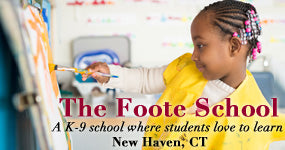You can’t accuse William Boughton of fiddling around. As the dapper music director and conductor of the New Haven Symphony Orchestra, he’s been instrumental in helping that august 120-year-old organization weather a period of economic and cultural turbulence.
In 2007, Boughton was one of 290 applicants for the head position with the orchestra. At the time, he was moored across the pond, with his wife Janet and children Jessica, 10, and Joe, 8. Wanting a change from his tenure as a conductor in Britain, he was debating whether to stay in Europe or come to the United States. He terms it “a challenge I relished, an adventure. The children were excited but also homesick initially to leave family and friends. Now they’ve settled in and love it.”
To Boughton, his role with the symphony early on was as a “provocateur.” After he arrived in mid-2007, the symphony experienced “tough times with an economic collapse, endowments down, audiences dwindling and dying off. There were a number of challenges that had to be addressed.” And those challenges are fundamentally bigger for the NHSO than they are for the kinds of orchestras he was used to in Europe, where state funding can compose 50% of the budget or more.
sponsored by

Fortunately, NHSO’s outlook is more positive now, particularly since the arrival of executive director Elaine Carroll in 2011. It means a more vital orchestra, in the black and on the rise, an appropriately far cry from its humble beginnings in 1894, when a German immigrant named Morris Steinert assembled a handful of amateur musicians to rehearse above his piano store. Original members couldn’t have anticipated that it would still be around 120 years later, or that it would be entering a new era of prosperity.
One of Boughton’s goals is to make the New Haven Symphony Orchestra “relevant to the community, especially in the area of music education,” since “music education is no longer a priority” in many schools. He wants the orchestra’s members to be “ambassadors and pioneers in music education,” and like an ambitious chef, he hopes “to create a wonderful menu, with appetizers, main courses and desserts.”
Right now, the NHSO is reaching 25 to 30 thousand school children a year across the state, including via concerts that offer special incentives like free or discounted tickets. In Fair Haven, Boughton even volunteers to teach the cello to students who otherwise wouldn’t have access to a musical instrument, and would therefore miss the benefits musical training provides. “Music does so many things,” he says.“A young person can use a musical instrument to pour out his heart and soul, to be another voice, to communicate through that voice, to discover self-determination and develop pride.”
sponsored by
In addition to cultivating the interests of young people, Boughton has tried to support a less traditional repertoire of American composers. For him, learning about them has been a “fascinating journey. I knew about Bernstein, Copland and the Gershwins, but I didn’t know contemporary American music.” Under Boughton, the NHSO’s incorporated works by “composers like Christopher Theofanidis, Augusta Read Thomas, Daniel Bernard Roumain and Chris Brubeck.” When selecting pieces to perform each season, he says he goes into a “war room,” a wonderfully frank space that he and other higher-ups use “to fight over new selections, keeping in the forefront the message and vision of fostering and developing American music,” while also celebrating the classics.
A big part of that vision involves taking musical projects farther outside Woolsey Hall, which has been the group’s performance HQ since Yale built it in 1901. In recent months, programs like “Best of Broadway” played at Hamden and Shelton Middle Schools and a thrilling “American Rhapsody” concert, built around Gershwin’s Rhapsody in Blue and teenage piano prodigy Emily Bear, at New Haven’s Shubert Theater.
Next up is an exciting first-time partnership with Yale Opera to present a double-feature: Puccini’s opera Suor Angelica and the New England premiere of Christopher Theofanidis’s Virtue. On November 20 and 21, the guest-conducted production, titled “Puccini, Virtue and Redemption,” will be fully staged—costumes and all—within the breathtaking climes of St. Mary’s Church on Hillhouse Avenue, the second-oldest Catholic church in the state. Hitting the road as it’s so wont to do do these days, the NHSO will perform a concert version of Suor the next evening at the Cathedral of Saint Joseph in Hartford.
The orchestra is traveling into homes as well through two recently released records, one featuring the music of Augusta Read Thomas, a composer in residence between 2009 and 2011 who’s been hailed by The New Yorker as a “true virtuoso composer” and by The Guardian as “vividly imaginative.” A Portrait of Augusta Read Thomas celebrates her 50th birthday and features the Elm City Girls’ Choir. William Walton Project Disc II, the second album, features the music of that very English composer, most of whose original manuscripts are held at the Beinecke Rare Book & Manuscript Library at Yale.
Whether through concerts or recordings, classics or pops, holiday themes or opera collaborations, works aimed at young people or programs to promote high school composers, the NHSO continues its long and fruitful relationship with Greater New Haven thanks to the efforts of administrators, performers and, of course, Mr. Boughton, with brains, bows and baton at the ready.
New Haven Symphony Orchestra
Offices – 105 Court St, Ste 302, New Haven (map)
Woolsey Hall – 500 College St, New Haven (map)
(203) 865-0831
www.newhavensymphony.org
Written by Bonnie Goldberg. Photographed by Joe Crawford.









